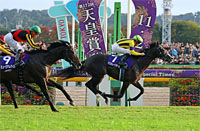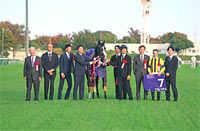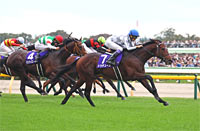2015 News
Data Analysis for the “2015 Tenno Sho (Autumn) (G1)”Elite horses enter battle to decide the middle-distance champion Horses can take various routes to reach the Tenno Sho (Autumn). As well as the big names from middle- to long-distance G1 turf racing, others have risen to prominence in the Summer 2000 Series* and warm-up races immediately prior to this one. Others still are 3-year-olds with their sights set on turf middle-distance racing, sidestepping the Kikuka Sho (Japanese St. Leger). This variety of contestants makes it harder to compare ability – which could explain why the Tenno Sho (Autumn) often ends in uproar. To illustrate this, 2005 winner Heavenly Romance romped home with win odds of 75.8 (14th favorite), while runners backed by win odds of 10 or more have triumphed in each of the last four years. So which horse will etch its name in the annals of racing history by winning this tradition-steeped race? This time, let’s analyze attributes shared by strong performers from race results over the last 10 years. * Summer 2000 Series: A series of five races (Tanabata Sho, Hakodate Kinen, Kokura Kinen, Sapporo Kinen and Niigata Kinen) held from July to September. Check the track record in middle- to long-distance turf racing at Tokyo All 30 top 3 finishers over the last 10 years had already experienced a top 3 finish in a JRA G1 or G2 turf race with a distance of 1,800m or more. Little can be expected from horses with experience of success only in G3 or Open Stakes races, or over distances of mile or less. [Table 1] [Table 1] Performance by top 3 finishes in JRA G1 or G2 turf races over 1,800m+ (last 10 years)
What’s more, 24 of the 30 horses meeting the condition in Table 1 had done so in a G1 or G2 turf race run over 1,800m or more at Tokyo. These horses have also scored higher success ratios, including a top 3 ratio of 27.9%. It seems we can place our trust in horses with experience of success in middle- to long-distance G1 and G2 turf races at Tokyo, like this one. [Table 2] [Table 2] Of horses meeting the condition in Table 1, performance by top 3 finishes in G1 or G2 turf races over 1,800m+ at Tokyo (last 10 years)
Strong showing by fillies & mares Of 174 entrants over the last 10 years, only 16 have been “Fillies and mares” – yet half of them (8) have finished in the top 3. These include Heavenly Romance, winner as 14th favorite in 2005, and Dance in the Mood, placed 3rd as 13th favorite in the same race (producing a mammoth Trifecta payout of 1,226,130 yen). It would be useful to check if any fillies and mares are running this year. [Table 3] [Table 3] Performance by gender (last 10 years)
Discount runners in outer brackets A look at performances by bracket number over the last eight years shows that every horse in “Bracket 8” has been beaten to 4th or lower in that time. Those in “Bracket 7” have fared little better, with a top 3 ratio of only 9.5%. And since 2008 winner Vodka, no horse in “Bracket 7” has finished in the top 2. Runners in brackets 7 and 8 were performing well up to 2006, but trends in recent years suggest we should discount horses in the outer brackets. [Table 4] [Table 4] Performance by bracket number (last 8 years)
Previous race and finish are key points Of 24 top 3 finishers over the last eight years, 16 had most recently appeared in the “Takarazuka Kinen” or the “Mainichi Okan”. By contrast, runners coming straight from “Other races” have struggled, with a top 3 ratio of only 10.5%. So we should first be checking for horses last seen in the Takarazuka Kinen or the Mainichi Okan as warm-up race. [Table 5] [Table 5] Performance by previous race (last 8 years)
Moreover, of horses previously seen in the Takarazuka Kinen or the Mainichi Okan, those finishing “In the top 3” there have marked even better success ratios here, including a top 3 ratio of 48.0%. Horses with good records in the Takarazuka Kinen and Mainichi Okan seem the more reliable bet. [Table 6] [Table 6] Performance in the previous race when it was the Takarazuka Kinen or the Mainichi Okan (last 8 years)
Meanwhile, of horses most recently seen in races other than the Takarazuka Kinen and the Mainichi Okan, those beaten to “2nd or lower” in that race have achieved little success here, with a top 3 ratio of only 2.2%. We should not expect too much of horses coming straight from races other than the Takarazuka Kinen and the Mainichi Okan, if they failed to win that race. [Table 7] [Table 7] Performance by finish in the previous race when not the Takarazuka Kinen or the Mainichi Okan (last 8 years)
Not much promise from horses with low favoritism last time out All 15 top 3 finishers over the last five years had most recently contested a JRA race, and had been backed by win odds of “Less than 10” in that race. Conversely, all 42 horses backed by win odds of “10 or more” have been beaten to 4th or lower here. Horses with low favoritism last time out would appear likely to struggle here, even if their finish was good in that race. [Table 8] [Table 8] Performance by win odds in previous race (last 5 years)
Seek out the winner! Dominance of young horses (up to 5yo) Each of the last five winners has been aged “5 or under”. Other attributes shared by these five are that they had all experienced a top 3 finish in a G1 or G2 turf race over 1,800m or more at Tokyo, were all in bracket numbers “1-6”, and all had win odds of “Less than 10” last time out. Any runner aged “5 or under” that meets the conditions in Tables 2, 4 and 8 could be a leading contender to win this race. [Table 9] [Table 9] Winners’ age, highest finish in 1,800m+ G1 or G2 turf races at Tokyo, bracket number, and win odds in the previous race (last 5 years)
(Data analysis by Masaya Ibuki) |
|


















